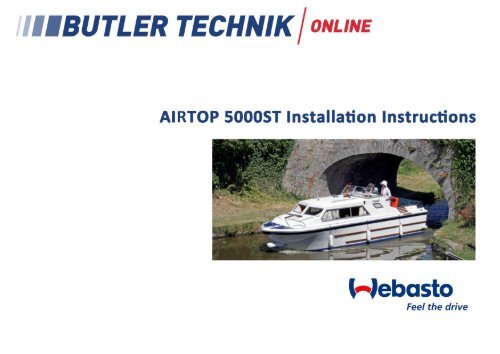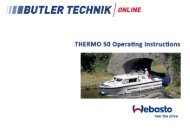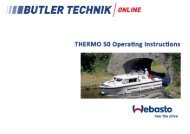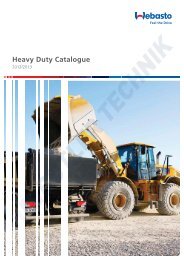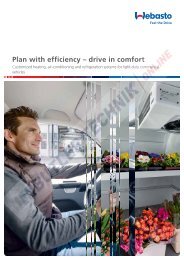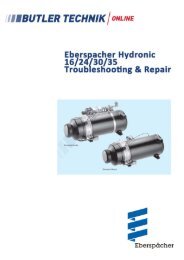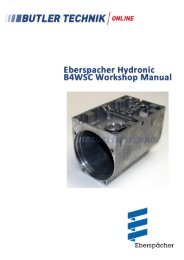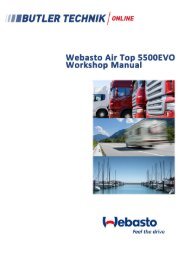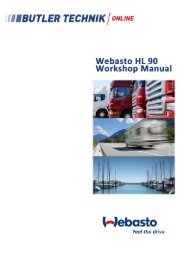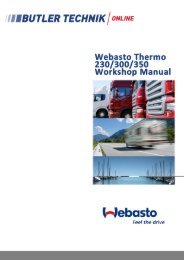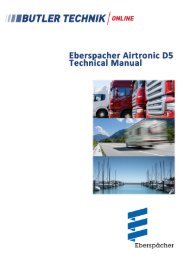Webasto AIRTOP 3500/5000 Installation Instructions
The full installation instructions for the Webasto AIRTOP 3500/5000 air heaters.
The full installation instructions for the Webasto AIRTOP 3500/5000 air heaters.
Create successful ePaper yourself
Turn your PDF publications into a flip-book with our unique Google optimized e-Paper software.
Air Heaters<br />
<strong>Installation</strong> instructions<br />
Air Top <strong>3500</strong><br />
Air Top <strong>5000</strong><br />
Type Air Top <strong>3500</strong> B (Petrol<br />
Type Air Top <strong>3500</strong> D (Diesel)<br />
Type Air Top <strong>5000</strong> B (Petrol)<br />
Type Air Top <strong>5000</strong> D (Diesel)<br />
12/1998
Air Top <strong>3500</strong>/<strong>5000</strong><br />
Table of Contents<br />
<strong>Installation</strong> <strong>Instructions</strong><br />
Page<br />
Legal Provisions for <strong>Installation</strong> 1<br />
<strong>Installation</strong> 3<br />
<strong>Installation</strong> Example 5<br />
Heating Air System 6<br />
Fuel Supply 7<br />
Combustion Air Supply 10<br />
Exhaust Pipe 10<br />
Electrical Connections 12<br />
Circuit Diagrams 15<br />
Initial Operation 22<br />
Shut-Down on Faults 22<br />
Technical Data 23<br />
Drilling Template 25<br />
<strong>Webasto</strong> Service Phone 27<br />
II
Air Top <strong>3500</strong>/<strong>5000</strong><br />
<strong>Installation</strong> <strong>Instructions</strong><br />
Legal Provisions for <strong>Installation</strong><br />
For testing the heater in accordance with §§ 19, 20 or 21<br />
StVZO (German Road Licensing Regulations) the following<br />
regulations are primarily to be observed (§ 22 a<br />
StVZO):<br />
NOTE:<br />
These provisions are binding within the scope of the<br />
StVZO and should also be observed in countries<br />
where no special regulations are in effect!<br />
Within the scope of the StVZO (German Road Licensing<br />
Regulations) “General Design Certifications” have been<br />
granted by the Federal Office for Motor Traffic for the Air<br />
Top <strong>3500</strong>/<strong>5000</strong> air heaters with the following design approval<br />
numbers:<br />
~ S 305 Air Top <strong>3500</strong> B<br />
~ S 306 Air Top <strong>3500</strong> D<br />
~ S 304 Air Top <strong>5000</strong> B<br />
~ S 303 Air Top <strong>5000</strong> D<br />
The installation of the heaters must be performed in accordance<br />
with these <strong>Installation</strong> <strong>Instructions</strong>. The installation<br />
must be checked<br />
a) upon the homologation of the vehicles in accordance<br />
with § 20 StVZO<br />
b) upon any individual test in accordance with<br />
§ 21 StVZO, or<br />
c) upon any examination in accordance with<br />
§ 19 StVZO by a registered expert or examiner for<br />
motor traffic, an expert for automotive vehicles,<br />
or any other authorised official, in accordance with<br />
paragraph 7.4 a of Appendix VIII to the StVZO<br />
and in the case of item c) the proper installation must be<br />
certified on the approval certificate contained on the design<br />
certification stating the following:<br />
- vehicle manufacturer<br />
- vehicle type and<br />
- vehicle identification number<br />
The effectiveness of the design certification (homologation)<br />
is dependent on this certificate. The approval certification<br />
is to be kept in the vehicle.<br />
The year of the initial operation must be durably marked<br />
on the type plate of the heater by the installer by removing<br />
the years that do not apply.<br />
The heat exchanger of the air heater is not to be used<br />
for longer than ten years and must thereafter be replaced<br />
by the manufacturer or one of its authorised<br />
dealers with a genuine replacement part.<br />
If exhaust pipes lead through passenger areas, these<br />
pipes must also be replaced with genuine replacement<br />
parts after ten years.<br />
Whenever the heater is removed it is imperative that<br />
the gasket located underneath be replaced.<br />
The heaters are approved for heating the passenger compartment<br />
and the driver’s cabin, not however, the cargo<br />
space for the transport of hazardous materials.<br />
When using the heater in special vehicles (e.g. “TRS” vehicles<br />
for the transport of hazardous materials) or in vehicles<br />
not subject to StVZO regulations (e.g. ships) all regulations<br />
that may be locally applicable are to be complied<br />
with.<br />
When installing the Air top <strong>3500</strong>/<strong>5000</strong> D heater in vehicles<br />
for the transport of hazardous materials the requirements<br />
laid down in TRS 002 and TRS 003 (Technical Guidelines<br />
relating to the ordinance of transporting hazardous<br />
materials on the road) must be fulfilled in addition to those<br />
of the StVZO.<br />
“Heating air system”:Heating air intake openings must<br />
be so arranged that the possibility of exhaust fumes from<br />
the vehicle engine and the heater being drawn in is remote<br />
under normal operating conditions.<br />
Extracting the combustion air from the interior of the vehicle<br />
is not permissible.<br />
“Combustion air pipe: The combustion air required<br />
must be drawn in from the outside of the vehicle.<br />
Inside passenger areas the combustion air lines are permitted<br />
to have a maximum of four joints and must be provided<br />
with a splash-proof opening leading through the outside<br />
wall. These joints must be so sealed that a total leakage<br />
rate of 200 l/h at an overpressure of 0.5 mbar is not exceeded.<br />
The pipe including lead-through, joints, material and type<br />
of construction must be specified in the installation instructions.<br />
Mounting and removal of the pipe must be possible with<br />
tools only, the pipe must be protected against damage and<br />
be permanently vibration-proof.<br />
“Exhaust gas pipe”: The heaters must be so designed<br />
that the exhaust fumes are discharged to the atmosphere.<br />
Exhaust pipes must be so routed that the possibility of exhaust<br />
gases penetrating the interior of the vehicle is<br />
remote. The functioning of any parts of the vehicle essential<br />
for its operation must not be impaired. Any condensate<br />
or water that may have entered must not be able to collect<br />
in the exhaust gas line. Drain holes are permissible; these<br />
must discharge the liquid to the atmosphere via lines that<br />
are leakproof in relation to the interior of the vehicle.<br />
The discharge opening of the exhaust pipe is to point upward,<br />
sideways or, in the case of routing the exhaust pipes<br />
on the underside of the bottom of the vehicle, it must be positioned<br />
near the lateral or rear edge of the driver’s cab or<br />
vehicle.<br />
Inside areas where people are present, exhaust pipes may<br />
have a maximum of one joint, and their lead-through<br />
through the outer wall/bottom of the vehicle must be<br />
splash-proof. It is permissible to connect a drain pipe provided<br />
with a leak-proof metal joint to discharge the water<br />
penetrated into the exhaust pipe. The drain pipe is to be<br />
passed through the outside wall or the bottom of the ve-<br />
1
Air Top <strong>3500</strong>/<strong>5000</strong><br />
hicle through a sealed bush.<br />
The heat exchanger, the connected exhaust pipe as well<br />
as any drain pipe that may be connected must be so<br />
sealed that in the event of an overpressure equivalent to<br />
the twofold overpressure of the exhaust gas at maximum<br />
permissible exhaust pipe length – however, at a minimum<br />
overpressure of 0.5 mbar – a leakage rate of a total of 30<br />
l/h is not exceeded.<br />
The pipe including lead-through, joints, material and type<br />
of construction must be specified in the installation instructions.<br />
Mounting and removal of the pipe must be possible with<br />
tools only, it must be protected against damage and be permanently<br />
vibration-proof.<br />
Only metal pipes may be used. These must not exceed a<br />
temperature of 110 °C if the possibility of accidental contact<br />
in the vehicle’s interior exists. It is permissible to install<br />
a protection against accidental contact.<br />
“Combustion Air Inlet” and “Exhaust Gas Outlet”:<br />
During installation it must be ensured that the openings of<br />
the combustion air inlet and exhaust gas outlet pipes are<br />
so designed that a spherical object of 16 mm diameter cannot<br />
be introduced.<br />
Electric lines, switchgear and controlgear of the heater<br />
must be so arranged in the vehicle that their functioning<br />
cannot be impaired under normal operating conditions.<br />
All tubes leading from the heater toward the outside must<br />
be routed through splashwater-proof openings.<br />
In the case of buses, the heater must be installed neither<br />
in the driver’s compartment nor in the passenger area.<br />
their operation, and must be located such that dripping or<br />
evaporating fuel can neither collect nor be ignited by hot<br />
components or electrical equipment.<br />
In the case of buses, fuel lines and fuel tanks may be located<br />
neither in the passenger area nor in the driver’s compartment.<br />
In these vehicles the fuel tanks must be located<br />
such that they do not pose a direct hazard to the exits in<br />
the event of a fire. The fuel must not be supplied by means<br />
of gravity or gauge pressure in the fuel tank.<br />
Mounting instructions for <strong>Webasto</strong> fuel tanks for fuel supply<br />
of heating units in vehicles:<br />
In the case of buses, installation must not be performed in<br />
the passenger area or in the driver’s compartment.<br />
The fuel filler neck must not be located inside the passenger<br />
area or the driver’s compartment in any vehicle.<br />
Petrol fuel tanks must not be located directly behind the<br />
front panelling of the vehicle.<br />
They must be separated from the engine in such a manner<br />
that the possibility of fuel inflammation is remote even in<br />
the event of an accident. This does not apply to tractor vehicles<br />
with open cabs.<br />
The operating state of the heater at any given time – i.e. at<br />
least whether it is on or off – must be easily recognizable.<br />
<strong>Webasto</strong> will not assume any liability if the installation instructions<br />
and the notes contained therein are not observed.<br />
The same applies to improperly performed repairs<br />
or those where others than genuine replacement parts<br />
have been used. In those cases, the heater’s General Design<br />
Certification and thus the vehicle’s General Operating<br />
Permit (homologation) will be invalidated as a consequence.<br />
For the routing of fuel lines and the installation of additional<br />
fuel tanks, articles 45 and 46 StVZO are to be adhered to.<br />
The most important excerpts therefrom are as follows:<br />
Fuel lines are to be designed in such a way that their stability<br />
remains unaffected by torsional stresses in the vehicle,<br />
engine movement and the like. They must be protected<br />
against mechanical damage. All parts of the fuel system<br />
must be protected against heat which would impair<br />
2
Air Top <strong>3500</strong>/<strong>5000</strong><br />
Scope of Application of the Air Heaters<br />
The <strong>Webasto</strong> Air Top <strong>3500</strong>/<strong>5000</strong> air heaters are designed<br />
to provide the following features:<br />
- for the heating of driver’s cabs, boats, trucks, small<br />
buses, vans and ambulance vehicles<br />
- defrosting the vehicle’s windows.<br />
The heaters operate independently of the vehicle engine<br />
and are connected to the fuel tank and the electrical system<br />
of the vehicle.<br />
They can be used in vehicles with water-cooled or aircooled<br />
engines.<br />
<strong>Installation</strong><br />
CAUTION:<br />
The legal provisions 1 and 2 relating to the installation are<br />
to be adhered to.<br />
It is not permitted to operate the heater without control unit<br />
cover (results in overheating of the heater).<br />
<strong>Installation</strong> Details for Air Top <strong>3500</strong>/<strong>5000</strong><br />
NOTE:<br />
The different vehicle-specific installation conditions should<br />
be taken into account.<br />
<strong>Installation</strong> Location<br />
The heater can be fitted both inside and outside the vehicle.<br />
When installed on the outside, care must be taken<br />
that the heater is fitted in a location that is protected<br />
against splashwater and spray.<br />
1 Heating air inlet<br />
2 Heating air outlet<br />
3 Combustion air inlet<br />
4 Exhaust gas outlet<br />
5. Fuel inlet<br />
Fig. 1:<br />
Dimensions of the Heater<br />
6 Space required for heating air inlet<br />
7 Space required for heating air outlet<br />
8 Space required for removal of heater<br />
9 Cable outlet (optionally on the right or left)<br />
3
Air Top <strong>3500</strong>/<strong>5000</strong><br />
If installed in the vehicle’s interior, the lead-through openings<br />
for combustion air inlet, exhaust gas outlet and fuel<br />
pipe must be splash-water protected.<br />
For this purpose, the special gasket supplied with the<br />
heater must be used (see Fig. 4). The gasket must be<br />
renewed prior to each re-installation.<br />
A gasket (Fig. 4) must be fitted between heater and car<br />
body. The gasket must be renewed prior to each reinstallation.<br />
The support surface for the heater mounting<br />
foot must be level. A special tool is available from the<br />
manufacturer for drilling the holes and levelling the support<br />
surface, if necessary. Surface irregularities of up to max. 1<br />
mm can be compensated for by means of the gasket.<br />
Diesel-fuelled heaters<br />
0 - 90° 0 - 90° 0 - 90°<br />
CAUTION:<br />
After the installation has been performed, a check must be<br />
carried out to verify that no part of the housing is in contact<br />
with any surrounding parts. Non-compliance could result in<br />
a blockage of the heater fan.<br />
Fig. 3:<br />
Hole Pattern<br />
petrol-fuelled heaters<br />
0 - 30°<br />
0 - 90° 0 - 90°<br />
Name Plate<br />
The type plate must be located at a place where it is protected<br />
against damage and be easily accessible once the<br />
heater has been installed (or else, a type plate duplicate is<br />
to be used).<br />
The years not applicable are to be removed from the type<br />
plate.<br />
Fig. 2:<br />
Permissible <strong>Installation</strong> Positions<br />
Fig. 4:<br />
Gasket<br />
Unobstructed installation to be ensured!<br />
Mounting the Heater<br />
When mounting the Air Top <strong>3500</strong>/<strong>5000</strong> heater, the M 6 nuts<br />
must be tightened to a torque of 6 Nm +1 Nm.<br />
The mounting dimensions as well as the space required<br />
for the performance of servicing work are shown in the installation<br />
drawing (Fig. 1). The specified horizontal and<br />
axial angles of inclination must not be exceeded (Fig. 2).<br />
Fig. 5:<br />
<strong>Installation</strong><br />
4
Air Top <strong>3500</strong>/<strong>5000</strong><br />
1 Heater control dial<br />
2 Heater<br />
3 Metering pump and damping device<br />
4 Fuel filter (accessory)<br />
5 Tank extracting device<br />
6 Exhaust silencer (accessory)<br />
7 Fuse<br />
1<br />
2<br />
7<br />
3<br />
4<br />
5<br />
6<br />
Fig. 6:<br />
<strong>Installation</strong> example of air heater in the recirculating air mode<br />
5
Air Top <strong>3500</strong>/<strong>5000</strong><br />
Heating Air System<br />
NOTE:<br />
It is not permissible to integrate the heater into the vehicle’s<br />
air ducting system.<br />
Both recirculated-air and fresh-air operation is permissible.<br />
In the case of fresh-air operation, care must be taken that<br />
the heating air is extracted from an area that is protected<br />
against splashwater and spray.<br />
NOTE:<br />
In the case of fresh-air operation, an external temperature<br />
sensor must be mounted within the space to be heated.<br />
A temperature sensor is installed in the heater on the heating<br />
air intake side which, in conjunction with the heater control<br />
element and dependent upon the intake temperature<br />
and position of the setpoint transmitter, operates the<br />
heater within the appropriate heat output range. Heat output<br />
is so adjusted that after a quick reaching of the preset<br />
interior temperature the same will be maintained at the<br />
preset value.<br />
Minimum inside diameter of heating air pipe is<br />
90 mm at Air Top <strong>5000</strong><br />
80 mm at Air Top <strong>3500</strong><br />
may be decreased to 75mm subject to prior approval by<br />
the manufacturer.<br />
NOTE:<br />
For heating air ducts only materials capable of withstanding<br />
a temperature of at least 150° may be used.<br />
The hot air discharge opening is to be located so that the<br />
hot air is not directed onto parts that are not resistant to<br />
heat.<br />
CAUTION:<br />
In vehicles designed for the transportation of passengers,<br />
the air outlet openings must be arranged in such a way<br />
that they cannot be obstructed by passengers.<br />
Maximum air pressure drop between intake and delivery<br />
side of the heating air line:<br />
Air Top <strong>3500</strong> 2,0 mbar (20 mm WH)<br />
Air Top <strong>3500</strong> Volume Plus 3,0 mbar (30 mm WH)<br />
Air Top <strong>5000</strong> 3,0 mbar (30 mm WH)<br />
The test can also be performed by measuring the temperature<br />
directly at the heater:<br />
temperature difference between heating air inlet and hot<br />
air outlet max. 130 K.<br />
If this value is exceeded, the temperature limiter is expected<br />
to trip. The heating air hose is to be secured at the<br />
joints.<br />
The hot air stream must be prevented from re-entering the<br />
heater, if the heater is operated in the recirculating mode<br />
without any hot air ducting<br />
Fig. 7:<br />
Heating air inlet and heating air outlet<br />
CAUTION:<br />
If the heater is operated without heating air intake hose, it<br />
is imperative that the air intake grille supplied with the<br />
heater be mounted!<br />
NOTE:<br />
The installation must be checked for the following:<br />
- “closed circuit” of air between the vehicle heater and the<br />
heater air inlet<br />
- “closed circuit” of air between heater air inlet and heater<br />
air outlet (fig. 7)<br />
- adequate space for taking in heating air (heating air to be<br />
extracted from the cool space of the cabin, e.g. in the<br />
case of installation underneath a bunk)<br />
Fig. 7a:<br />
Heating air inlet with intake grille<br />
If an installation housing is used, the area around the air<br />
discharge nozzle must be tightly sealed so that no hot air<br />
can enter the installation box.<br />
External Temperature Sensor<br />
The installation of an external temperature sensor is recommended<br />
if the heater is installed in an installation housing<br />
or in location with poor ventilation (e.g. under-neath<br />
bunks). Extremely short cycle times of the heater can thus<br />
be avoided.<br />
Mounting of External Temperature Sensor<br />
The external temperature sensor must be mounted on surfaces<br />
as vertical as possible, at mid-height in the vehicle<br />
cab in the area to be heated.<br />
The temperature sensor must not<br />
- be located directly in the hot air stream (vehicle’s or<br />
heater’s heating air).<br />
- be mounted in the vicinity of heat sources<br />
(e.g. vehicle’s heating system).<br />
- be exposed to direct sun radiation (e.g. on the<br />
dashboard).<br />
- be mounted behind curtains or the like.<br />
6
Air Top <strong>3500</strong>/<strong>5000</strong><br />
Fuel Supply<br />
Fuel is extracted from the vehicle’s fuel tank or a separate<br />
fuel tank. The values relating to the permissible pressure<br />
at the fuel extraction point are shown in Fig. 8.<br />
permissible fuel feed height<br />
H (m)<br />
at max. permissible<br />
overpressure (bar) in fuel<br />
line<br />
0.00 0.2<br />
1.00 0.11<br />
2.00 0.03<br />
permissible fuel suction<br />
height S (m)<br />
at max. permissible<br />
underpressure (bar) in fuel<br />
tank<br />
0.00 -0.10<br />
0.50 -0.06<br />
1.00 -0.02<br />
l 2<br />
l 1<br />
l 2<br />
l 1 + l2 ≤ 10 m<br />
l 1 ≤ 1,2 m<br />
l 2 ≤ 8,8 m<br />
l 1<br />
Fig. 8:<br />
Fuel Supply<br />
7
Air Top <strong>3500</strong>/<strong>5000</strong><br />
Vehicles with Carburetor Engines<br />
In passenger cars, fuel may only be extracted with the special<br />
<strong>Webasto</strong> fuel pickup (see Fig. 8) and as close to the<br />
tank as possible. The connection can be made either in<br />
the flow or the return pipe whereby it must be ensured that<br />
the return pipe reaches almost to the bottom of the tank.<br />
Failing this, the return pipe can be extended.<br />
The fuel pickup is to be so mounted that any air or gas<br />
bubbles are automatically discharged into the tank (see<br />
Fig. 9).<br />
Vehicles with Fuel Injection Engines<br />
When installing the heater in vehicles with petrol injection<br />
systems it must be determined whether the fuel pump is<br />
mounted inside or outside the tank.<br />
Where the fuel pump is located inside the tank, the fuel<br />
can only be drawn from the return pipe and only by using<br />
the <strong>Webasto</strong> fuel pickup (see Fig. 8) whereby it must be<br />
ensured that the return pipe reaches almost to the bottom<br />
of the tank (minimum distance to tank bottom, see Fig. 10).<br />
Failing this, the <strong>Webasto</strong> tank extracting device (see Figs.<br />
9, 10 and 11) can be used.<br />
hole pattern<br />
minimum distance 25 mm<br />
Where the fuel pump is mounted outside the tank, the fuel<br />
may only be extracted between the tank and the fuel pump<br />
and also only by using the <strong>Webasto</strong> fuel pickup (see Fig. 8).<br />
Fig. 10:<br />
<strong>Webasto</strong> Tank Extracting Device<br />
* tank extracting device only to be used with<br />
metal fuel tanks<br />
Vehicles with Diesel Engines<br />
Fuel must be drawn from the fuel tank or a separate tank<br />
(see Figs. 9, 10 and 11). With this method of fuel being<br />
supplied from a separate tank, no pressure-related influence<br />
is possible.<br />
plastic tank<br />
from tank<br />
to engine<br />
sealing ring<br />
Fig. 9:<br />
to metering pump<br />
<strong>Webasto</strong> Fuel Pickup<br />
Fig. 11:<br />
Fuel Extraction From the Plastic Tank<br />
(Extraction Via Tank Drain Plug)<br />
Fuel should not be extracted in the vicinity of the engine<br />
since here gas bubbles are likely to form in the lines owing<br />
to the heat radiation of the engine, which may result in malfunctions<br />
of the combustion operation.<br />
8
Air Top <strong>3500</strong>/<strong>5000</strong><br />
fuel extracting<br />
device<br />
sealing ring<br />
the inside diameter must not exceed a given dimension.Starting<br />
with an inside line diameter of 4mm, air or<br />
gas bubbles will accumulate resulting in malfunctions of<br />
the combustion operation if lines sag or are routed with a<br />
downward pitch. When the diameters shown in Fig. 8 are<br />
used, you can be sure that no unwanted bubbles will be<br />
formed.<br />
The lines leading from the metering pump to the heater<br />
should not be routed in a downward pitch.<br />
Metering Pump<br />
The metering pump is a combined delivery/metering and<br />
shutoff system and is subject to certain installation criteria<br />
(see Figs. 8, 14 and 15).<br />
Air Top <strong>3500</strong>/<strong>5000</strong>, 12-volt Petrol<br />
tank fitting<br />
To prevent the fuel lines from sagging, freely suspended<br />
lines must be secured. Mounting should be performed in<br />
such a manner that the lines are protected against flying<br />
stones and thermal influence (exhaust pipe).<br />
To prevent the fuel lines from slipping off they are to be secured<br />
at the joints by means of hose clamps.<br />
preferably<br />
15°-90°<br />
Connecting Two Pipes Using a Hose<br />
The proper connection of fuel lines using a hose is shown<br />
in Fig. 13.<br />
Check for leakage!<br />
Fig. 14: Metering Pump DP 2<br />
<strong>Installation</strong> Position<br />
Fig. 12:<br />
Fuel Extraction From the Plastic Tank<br />
(Extraction Via Tank Fitting)<br />
correct<br />
clamp<br />
Air Top <strong>3500</strong>/<strong>5000</strong> D. 12-volt and 24-volt Diesel<br />
NOTE:<br />
The fitting must be made of sheet steel!<br />
incorrect<br />
Fuel Lines<br />
bubble<br />
bubble<br />
Only steel, copper and plastic pipes made of plasticized,<br />
light-resistant and temperature-stabilized PA 11 or PA 12<br />
(e.g. Mecanyl RWTL) in accordance with DIN 73378 may<br />
be used as fuel lines. As in the majority of cases it is not<br />
possible to route the lines in a continuous upward pitch,<br />
Fig. 13:<br />
Pipe/Hose Connection<br />
Fig. 15: Metering Pump DP 30<br />
<strong>Installation</strong> Position<br />
9
Air Top <strong>3500</strong>/<strong>5000</strong><br />
<strong>Installation</strong> Location<br />
The metering pump must be mounted in a cool location as<br />
close to the tank as possible (see Fig. 8). The permissible<br />
ambient temperature must not exceed a temperature of +<br />
20°C at any given operating state.<br />
Metering pump and fuel lines must not be mounted within<br />
the radiation range of hot vehicle parts. If necessary, a radiation<br />
protection is to be provided.<br />
<strong>Installation</strong> and Mounting<br />
The metering pump is to be attached by a vibration-damping<br />
suspension device (e.g. rubberized clamp). The installation<br />
position is restricted as shown in Figs. 14 and 15 in<br />
order to ensure proper self-bleeding of the system.<br />
Owing to the hazard of corrosion, only genuine <strong>Webasto</strong><br />
parts may be used for the plug connection between metering<br />
pump and metering pump cable harness.<br />
Fuel Filter<br />
If dirt in the fuel must be reckoned with, only <strong>Webasto</strong> filter,<br />
order no. 487 171, should be used. The filter is preferably<br />
be installed in vertical position, where this is not possible, it<br />
may also be installed horizontally (direction of flow to be<br />
observed).<br />
0 - 90°<br />
Combustion Air Supply<br />
On no account may the combustion air be extracted from<br />
areas where persons are present. The combustion air intake<br />
opening must not point in the direction of travel. It<br />
must be so located that the possibility of clogging due to<br />
contamination n is remote.<br />
NOTE:<br />
With an intake duct length < 0.6 m, it is compulsory that an<br />
intake silencer be mounted.<br />
NOTE:<br />
Combustion air must be drawn from a splash-water protected<br />
location that is as cool as possible. A combustion air<br />
line is to be used, if necessary.<br />
Exhaust gas pipes must not be used as combustion air<br />
lines as this would cause damage to the metering pump<br />
cable emerging from the combustion air intake fitting.<br />
For further regulations refer to the Legal Provisionsfor the<br />
installation.<br />
Exhaust Pipe<br />
Rigid pipes made of unalloyed or alloyed steel with a minimum<br />
wall thickness of 1.0 mm, or flexible tubes of alloyed<br />
steel only are to be used as exhaust pipes.<br />
The exhaust pipe is to be secured to the heater, e.g. by<br />
means of a clamp. For further regulations refer to the<br />
Legal Provisions.<br />
The exhaust silencer is preferably to be mounted in the vicinity<br />
of the heater.<br />
Operation of the heater is also permissible without exhaust<br />
silencer.<br />
Combustion Air Intake and Exhaust Pipes<br />
Both pipes leading away from the heater are to be routed<br />
in a downward pitch. If this is not possible, a ø 4mm condensate<br />
drain hole is to be provided at the lowermost point.<br />
Fig. 16:<br />
Fuel Filter<br />
Fig. 17:<br />
Exhaust Silencer<br />
Direction of flow optional<br />
Fig. 18:<br />
Prevent condensation from forming<br />
10
Air Top <strong>3500</strong>/<strong>5000</strong><br />
The lines must not point into the direction of travel.<br />
To ensure an angle of discharge of 90° ± 10°, it is required<br />
that the pipe clamp be attached no more than<br />
150 mm, from the exhaust pipe end<br />
Fig. 19:<br />
Pipe discharge openings not in direction of<br />
travel<br />
The lines must be so arranged that any clogging due to<br />
contamination is not to be expected.<br />
Fig. 20:<br />
Avoid areas exposed to water, mud or snow<br />
direction of discharge approximately vertical 90° ± 10°<br />
Fig. 21:<br />
Exhaust Pipe Discharge Opening<br />
<strong>Installation</strong> Position<br />
NOTE:<br />
For exhaust pipes lengths of 2 m and more, insulated exhaust<br />
pipes are to be used (dew point not reached)<br />
CAUTION:<br />
A fire hazard exists if the installation position of the exhaust<br />
pipe discharge opening differs from that shown in<br />
Fig. 21.<br />
Inside diameter of pipes:<br />
Combustion air pipe:<br />
Exhaust pipe (metal):<br />
Smallest bending radius:<br />
25 mm<br />
24 mm<br />
50 mm<br />
Length of combustion air intake and exhaust pipes:<br />
with exhaust gas silencer: max. 2.6 m<br />
without exhaust gas silencer: max. 5.6 m<br />
Total angle of all bends:<br />
Combustion air pipe: max. 270°<br />
Exhaust pipe: max. 270°<br />
11
Air Top <strong>3500</strong>/<strong>5000</strong><br />
Electrical Connections<br />
All pipes that are not required must be insulated!<br />
NOTE:<br />
When using the combination or standard digital timer a<br />
remote-control pushbutton may be provided near the bunk<br />
for added convenience. The connection is to be performed<br />
in accordance with wiring diagram 30 and 31.<br />
The electrical connection is to be performed in accordance<br />
with the system circuit (Fig. 29, 30, 31, 32, 33).<br />
Connection in Vehicles for the Transportation of Dangerous<br />
Goods (TRS)<br />
When installing the Air Top <strong>3500</strong>/<strong>5000</strong> D heaters in vehicles<br />
for the transport of hazardous materials, the requirements<br />
laid down in TRS 002 and TRS 003 (Technical Guidelines<br />
relating to the ordinance of transporting hazardous<br />
materials on the road) must be fulfilled in addition to those<br />
of the StVZO. The electrical connection is to be performed<br />
in accordance with wiring diagrams Fig. 32 or 33.<br />
On vehicles without auxiliary drives, electrical connection<br />
is to be performed in accordance with the system circuit diagram<br />
Fig. 33.<br />
NOTE:<br />
Switch S3 must be so installed that in the event of a pumping<br />
device being put into operation, a plus potential is applied<br />
across the corresponding input of the electronic control<br />
unit.<br />
CAUTION:<br />
If no voltage to ground is present at the control unit input<br />
X6/1 upon start-up all TRS functions will be inoperative.<br />
After the plus potential has been applied across the control<br />
unit input X6/1 (auxiliary drive ON) a short after-run period<br />
of 20 seconds takes place and subsequently the control<br />
unit is in its “fault lock-out” state.<br />
CAUTION:<br />
In accordance with the Technical Guidelines relating to the<br />
ordinance of transporting hazardous materials on the road,<br />
heaters may only be switched on by means of a special<br />
switch installed in the driver’s cabin and are to be actuated<br />
manually. If the heater is equipped with a combination or<br />
standard digital timer, it must ensured that pin 4 on the<br />
combination or standard digital timer remains unassigned.<br />
The heater can therefore only be started up by means of<br />
the instant heating button.<br />
No other digital timers are allowed to be used in TRS vehicles.<br />
Connection of the Heater<br />
To connect the cable harness, remove the control unit<br />
cover on the heater and connect the cable harness connectors<br />
with the control unit.<br />
Fig. 22:<br />
Removal of Control Unit Cover<br />
NOTE:<br />
Lift off control unit cover applying a blunt edge at its side<br />
(see arrows in Fig. 22)<br />
Be sure not to touch the printed conductors of the<br />
control unit.<br />
Prior to starting up the heater for the first time, reinstall the<br />
control unit cover to prevent any undue escaping of heating<br />
air (overheating of heater).<br />
Cable lead-through can optionally be located on the left or<br />
right.<br />
To ensure that the cable lead-through in the control unit<br />
cover provides a tight seal, the cable grommet on the<br />
cable harness must be displaced accordingly.<br />
Connection to Supply Voltage<br />
Preferably to be supplied from the vehicle central electrical<br />
system.<br />
To provide the heater with adequate protection, an additional<br />
flat fuse holder is to be installed (supplied<br />
with the heater). The fuse holder may only be installed<br />
in the vehicle interior.<br />
Fig. 23:<br />
F = 15A (24V)<br />
F = 20A (12V)<br />
Fig. 24:<br />
Removal of Mounting Plate of Fuse Holder<br />
Fuse Holder, <strong>Installation</strong> Position<br />
12
Air Top <strong>3500</strong>/<strong>5000</strong><br />
Connection of Heater Control Element<br />
The cable harness is prepared for connection to the heater<br />
control.<br />
To withdraw the connector pull at the connector housing<br />
only.<br />
If the cable harness is pulled, the connector housing is<br />
locked (self-locking).<br />
NOTE:<br />
The optical fiber must be in contact with the rotary knob.<br />
NOTE:<br />
As an option, an external temperature sensor can be installed<br />
in the passenger area (see page 6)<br />
Fig. 25:<br />
Heater Control Knob<br />
Correct!<br />
Fig. 26:<br />
Mounting of Heater Control Knob<br />
Incorrect!<br />
Fig. 27:<br />
Mounting of Heater Control Knob (incorrect)<br />
13
Air Top <strong>3500</strong>/<strong>5000</strong><br />
Jumper Terminal 15<br />
Terminal 58<br />
Terminal 30<br />
Terminal 31<br />
to isolate<br />
Fig.28:<br />
Connection diagram Air Top <strong>3500</strong>/<strong>5000</strong> ; only connection featuring a combination timer is shown.<br />
14
Air Top <strong>3500</strong>/<strong>5000</strong><br />
ϑ<br />
ϑ<br />
Fig.29: System circuit diagram Air Top <strong>3500</strong>/<strong>5000</strong>, 12V/24V with Control Knob, legend see page 20 and 21<br />
15
Air Top <strong>3500</strong>/<strong>5000</strong><br />
ϑ<br />
ϑ<br />
Fig.30: System circuit diagram Air Top <strong>3500</strong>/<strong>5000</strong>, 12V/24V with Combination Timer , legend see page 20 and 21<br />
16
Air Top <strong>3500</strong>/<strong>5000</strong><br />
ϑ<br />
ϑ<br />
Fig. 31: System circuit diagram Air Top <strong>3500</strong>/<strong>5000</strong>, 12V/24V with Combination Timer and electrical battery disconnecting switch, legend see page 20 and 21<br />
17
Air Top <strong>3500</strong>/<strong>5000</strong><br />
ϑ<br />
ϑ<br />
Fig.32: System circuit diagram Air Top <strong>3500</strong>/<strong>5000</strong> D, 24V TRS-Operation with Heater Control Knob , legend see page 20 and 21<br />
18
Air Top <strong>3500</strong>/<strong>5000</strong><br />
ϑ<br />
ϑ<br />
Fig. 33: System circuit diagramAir Top <strong>3500</strong>/<strong>5000</strong> D, 24V TRS-Operation with Heater Control Knob without auxiliary drive , legend see page 20 and 21<br />
19
Air Top <strong>3500</strong>/<strong>5000</strong><br />
Legende for circuit diagrams:<br />
➀ Positive voltage from terminal (15/75) to pin 10:<br />
continuous operation in the instant heating mode as<br />
long as ignition is switched on<br />
No positive voltage at pin 10:<br />
variable heating times can be programmed<br />
(10 min up to 120 min),<br />
basic setting: 120 min<br />
➁ Diagnostic K conductor<br />
➂ Diagnostic L conductor<br />
➃ Input pin (pin 7/connector X7, cable color in cable harness: white/red):<br />
“Ventilation” (blower speed is dependent on the heater control position)<br />
Min. wire cross sections per circuit<br />
Colour of cables<br />
bl blue<br />
< 7.5 m 7.5 - 15 m<br />
0.75 mm 2 1.5 mm 2<br />
br brown<br />
ge yellow<br />
1.0 mm 2 1.5 mm 2<br />
gn green<br />
gr gray<br />
1.5 mm 2 2.5 mm 2<br />
or orange<br />
2.5 mm 2 4.0 mm 2<br />
rt red<br />
sw black<br />
4.0 mm 2 6.0 mm 2 vi violet<br />
ws white<br />
➄ CO2 setting (see Workshop Manual)<br />
➅ NOTE:<br />
If connection is made to terminal 30, continuous heating operation is<br />
possible with the ignition turned off! In this case, no connection to<br />
terminal 15/75 must be made!<br />
➆ NOTE:<br />
For TRS function, gray and purple wires are required.<br />
20
Air Top <strong>3500</strong>/<strong>5000</strong><br />
Pos. Designation Remarks<br />
A1 Heater Air Top <strong>3500</strong>/<strong>5000</strong><br />
A2 Electronic control unit<br />
B2 Temperature sensor<br />
B3 Temperature sensor (limiter) Overheating protection<br />
E Glow plug / Flame detector<br />
F1 Fuse24V 15A/12V 20A flat fuse SAE J 1284<br />
F2 Fuse20A flat fuse SAE J 1284<br />
F3 Fuse max. 15A flat fuse SAE J 1284<br />
H1 LED green (in Pos. S1) operation indicator<br />
H3 LED red (in Pos. P) Display illumination instant heating button<br />
Operation indicator Operation indicator<br />
light<br />
H4 Heating symbol in display (in pos. P) Operation indicator<br />
H5 Lamps (in pos. P) Illumination of display and buttons<br />
H6 Lamp (min. 1.2W) Operation indicator light pumping device<br />
M1 Motor Combustion and heating air fan<br />
M3 Motor Vehicle fan<br />
P Combination timer (1531) Digital timer and setpoint generator<br />
S1 Control element Setpoint generator switch<br />
S2 Disconnecting switch 1 or 2 poles. Emergency Stop switch<br />
S3 Switch at or for pumping device<br />
Pos. Designation Remarks<br />
S6 Switch Ventilation<br />
S7 Push-button switch Instant heating button remote control<br />
S8 Battery disconnecting switch.<br />
V1 Diode<br />
V2 Diode<br />
X1 Connector 2pole atPos. A2 (ST B)<br />
X2 Connector 2pole at Pos. A2 (ST V)<br />
X3 Connector 2pole at Pos. A2 (ST U)<br />
X4 Connector 2pole at Pos. A2 (ST Z)<br />
X5 Connector 2pole at Pos. A2 (ST Y)<br />
X6 Connector 2pole at Pos. A2 (ST X)<br />
X7 Connector 12pole at Pos. A2 (ST1)<br />
X8 Connector 2pole<br />
X9 Connector 4pole at Pos. S1<br />
X10 Connector 2pole<br />
X11 Connector 2pole at Pos. Y1<br />
X12 Connector 12pole at Pos. P<br />
Y1 Metering pump,<br />
Y2 Solenoid valve for pumping device<br />
21
Air Top <strong>3500</strong>/<strong>5000</strong><br />
Initial Operation<br />
After the heater has been installed, the fuel supply system<br />
is to be bled thoroughly.<br />
NOTE:<br />
Owing to the low fuel consumption it is required that the<br />
heater be turned on repeatedly to fill the fuel line leading to<br />
the heater.<br />
During a test run of the heater all connections are to be<br />
checked for leakage and security. Should a malfunction of<br />
the heater occur during operation, fault isolating measures<br />
are to be performed.<br />
Shut-Down on Faults<br />
Faults related to individual heater components and malfunctions<br />
during the start-up sequence are detected in the<br />
control unit.<br />
The heater is shut down (fault lock-out) in the following<br />
cases:<br />
- no or unsuccessful start-up<br />
- temperature sensor defective<br />
- temperature limiter (interruption or short-circuit)<br />
- glow plug defective<br />
- insufficient fan speed, short circuit or interruption<br />
- fault in the metering pump circuit or overheat protection<br />
circuit (during start-up phase only)<br />
- undervoltage of less than 10 volts or overvoltage of<br />
more than 15 volts and for longer than 20 seconds<br />
(aplies to 12-volt heaters)<br />
- undervoltage of less than 20 volts or overvoltage of<br />
more than 32 volts and for longer than 20 seconds<br />
(on 24-volt heaters)<br />
- control unit defective<br />
- overheating<br />
Fuel supply will be interrupted in the event of overheating.<br />
An after-run cycle is performed as is the case when the<br />
heater is shut down manually.<br />
After the after-run cycle has been terminated, the control<br />
unit is in the fault lock-out state.<br />
An overheating condition is indicated by 10 flashing light<br />
signals of the operation indicator.<br />
Eliminate cause of malfunction.<br />
To deactivate the fault lock-out, the heater is to be briefly<br />
(min. 2 seconds) turned off and then switched back on<br />
again one time.<br />
Fault Code Display<br />
If the heater is equipped with a combination or standard<br />
digital timer, a fault code is indicated on the display of the<br />
digital timer whenever a malfunction has occurred:<br />
F 00 Control unit failure / incorrect parameter set /<br />
warm start detection<br />
F 01 No start-up (after 2 start-up attempts)<br />
no formation of flames<br />
F 02 Flame extinguished (repeated >5)<br />
F 03 Undervoltage or overvoltage<br />
F 04 Premature flame detection<br />
F 06 Temperature sensor interruption or<br />
temperature sensor short-circuit<br />
F 07 Metering pump interruption or<br />
metering pump short-circuit<br />
F 08 Fan motor interruption or<br />
fan motor short-circuit or<br />
fan motor incorrect speed<br />
F 09 Pencil-type glow plug interruption or<br />
pencil-type glow plug short-circuit<br />
F 10 Overheating<br />
F 11 Temperature limiter interruption or<br />
temperature limiter short-circuit<br />
F 12 Setpoint transmitter (interruption / short-circuit)<br />
22
Air Top <strong>3500</strong>/<strong>5000</strong><br />
Technical Data<br />
Unless tolerances are shown within the technical data<br />
table, a tolerance of ± 10% applies at an ambient temperature<br />
of +20°C and at the rated voltage and conditions.<br />
Electrical Components:<br />
Control unit, motor, fuel metering pump, light bulb in the<br />
digital timer* and pencil-type glow plug/flame detector are<br />
designed either for 12-volt or 24-volt operation.<br />
The digital timer*, temperature limiter and temperature sensor<br />
are voltage-independent components.<br />
* Presetting of heater operating times is not possible for<br />
TRS-operation<br />
Fuel for AT <strong>3500</strong>/<strong>5000</strong> B (Petrol):<br />
The fuel specified by the vehicle manufacturer is suitable<br />
as fuel for the heater.<br />
Fuel for AT <strong>3500</strong>/<strong>5000</strong> D (Diesel/Fuel Oil EL):<br />
The Diesel fuel specified by the vehicle manufacturer is<br />
suitable as fuel for the heater. Also EL class fuel oil – not,<br />
however, L type fuel oil – can be used provided it conforms<br />
to the usual quality on the German market in accordance<br />
with DIN 51603.<br />
Any negative effect caused by additives is not known.<br />
When the fuel for the heater<br />
is drawn from the vehicle’s fuel tank, the vehicle manufacturer’s<br />
specifications concerning additives are to be observed.<br />
When to changing to cold-resistant fuels, the heater must<br />
be operated for approx. 15 minutes to ensure that the fuel<br />
pump is filled with the new fuel.<br />
Heater Operation Air Top<br />
<strong>3500</strong> B<br />
Air Top<br />
<strong>3500</strong> D<br />
Air Top<br />
<strong>3500</strong> D<br />
Volume<br />
Plus<br />
Air Top<br />
<strong>5000</strong> B<br />
Air Top<br />
<strong>5000</strong> D<br />
Mark of approval ~S 305 ~S 306 ~S 306 ~S 304 ~S 303<br />
Type<br />
air heater with vaporizing type burner<br />
Heat output control range 1,5 – 3,5 kW 1,5 – 3,5 kW 1,5 – 5,0(5,5)* kW<br />
*booster setting for max.<br />
30 min.<br />
Fuel petrol Diesel petrol Diesel<br />
Fuel consumption<br />
*booster setting for max. 30 min.<br />
control range 0,17 – 0,46<br />
l/h<br />
0,17 – 0,42 l/h 0,19 – 0,66<br />
l/h<br />
(0,73)* l/h<br />
0,17 – 0,60<br />
l/h<br />
(0,66)* l/h<br />
Rated voltage 12 volts 12/24 volts 12 volts 12/24 volts<br />
Operating voltage range 10,5 – 15<br />
volts<br />
10,5–15/21–30 volts 10,5 – 15<br />
volts<br />
10,5–15/21–30<br />
volts<br />
Rated power consumption control range 15 – 36 W 15 – 36 W 15 – 90 W 15 – 90 W 15 – 90 W<br />
Permissible ambient temperature:<br />
Heater: - operation<br />
- storage<br />
Metering pump- operation<br />
- storage<br />
Heater control - operation<br />
- storage<br />
Perm. combustion air intake<br />
temperature<br />
Setting range for interior<br />
temperature<br />
Flow rate of heating air against<br />
0.5 mbar<br />
CO 2 content in exhaust gas<br />
(permissible operating range)<br />
Dimensions of heater<br />
Weight of heater<br />
-40°... +40°C<br />
-40°... +85°C<br />
-40°... +20°C<br />
-40°... +85°C<br />
-40°... +75°C<br />
-40°... +85°C<br />
-40°... +20°C<br />
+10 ... + 45 °C<br />
139 m 3 /h 139 m 3 /h 218 m 3 /h 218 m 3 /h 218 m 3 /h<br />
1,5 kW:5,0-8,0%<br />
3,5 kW:9,0-12,5%<br />
length 425 ± 2 mm<br />
width 148 ± 1 mm<br />
height148 ± 1 mm<br />
5,9 Kg<br />
1,5 kW:5,0-8,0%<br />
5 kW:9,0-12,5%<br />
23
Air Top <strong>3500</strong>/<strong>5000</strong><br />
Version<br />
Air Top <strong>3500</strong>/<strong>5000</strong> B (Petrol)<br />
Type Air Top <strong>3500</strong>/<strong>5000</strong> B<br />
Air heaters for petrol fuel<br />
(12 volts)<br />
Air Top <strong>3500</strong>/<strong>5000</strong> D (Diesel)<br />
Type Air Top <strong>3500</strong>/<strong>5000</strong> D<br />
Air heaters for<br />
“Diesel/EL Fuel Oil EL”<br />
(12 or 24 volts)<br />
Air Top <strong>3500</strong> Volume Plus D<br />
(Diesel)<br />
Type Air Top <strong>3500</strong> D<br />
Air heaters for<br />
“Diesel/EL Fuel Oil EL”<br />
(12 or 24 volts)<br />
24
Air Top <strong>3500</strong>/<strong>5000</strong><br />
Gasket<br />
NOTE:<br />
Max. floor unevenness in the<br />
vicinity of the gasket: 1mm<br />
Fig. 34:<br />
Drilling template<br />
25
Air Top <strong>3500</strong>/<strong>5000</strong><br />
26
subject of modification<br />
<strong>Webasto</strong> Thermosysteme GmbH<br />
82131 Stockdorf . Kraillinger Str. 5 . Telefon (089) 85794-0<br />
Telefax (089) 8 57 94-448 . Telex 5 23 647 webas d


